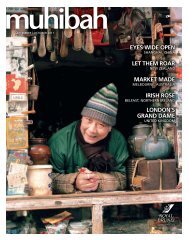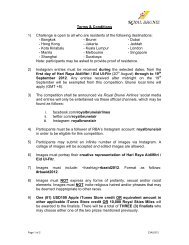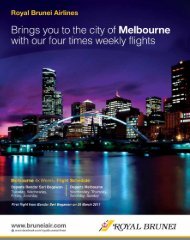THE PEOPLE'S MONARCH - Royal Brunei Airlines
THE PEOPLE'S MONARCH - Royal Brunei Airlines
THE PEOPLE'S MONARCH - Royal Brunei Airlines
Create successful ePaper yourself
Turn your PDF publications into a flip-book with our unique Google optimized e-Paper software.
ove Once the playground for Europe’s rich aristocrats and<br />
the Portuguese royal family, Cascais (pronounced<br />
Cash-kaISH) today courts the young and stylish<br />
with its sophisticated vibe and relaxed atmosphere. Holidaymakers<br />
are discovering the magic that has made Cascais known as the Coast<br />
of Kings. They fall in love with the sinewy streets that snake their way<br />
pass whitewashed villages, the dreamy dune landscape dotted with<br />
seasonal foliage, and the dramatic, heart-stopping cliffs overlooking<br />
the magnifi cent Atlantic Ocean. It is against this backdrop that<br />
Peugeot unveils its new 208, the successor of the famous 207, designed<br />
primarily to bring sexy back in its hatchback.<br />
It’s not surprising to have Peugeot choose Cascais as the point of which<br />
to test drive the new 208. A town with a rich and colourful history,<br />
Cascais seems to mirror the evolution of the 208 and its glorious<br />
heritage passed down from the 205 model. There was Cascais’ compact<br />
size to refl ect the style of the 208, the palm-brushed beach and lazy<br />
joie de vivre to celebrate the model’s new-found aesthetics, and the<br />
town’s relaxed spirit that encapsulates the emotion of the driving<br />
experience. Once the car was in front of us, stepping inside, it was<br />
immediately clear that the team at Peugeot had put a lot of thought<br />
into rekindling the romance between driving and driver.<br />
The fi rst initial thought upon taking to the wheels was that driving<br />
was certainly a pleasure. The luxurious comfort of space at the front<br />
was undeniable, where driver also has seat height adjustment. Rear<br />
passengers might fi nd the 5cm extra space up from 207’s model a bit<br />
welcoming, but with the sloping roofl ine, adults are better off giving<br />
up this space for kids. The story at the back was similar, with the boot<br />
growing by 15 litres to 285 litres. The panoramic roof, ambient lighting<br />
and tactile mix of metal and leather just add to the sophisticated fl air.<br />
There’s also the tiny, go kart-style steering wheel to start conversation.<br />
Some may fi nd it surprising, but this purpose-designed wheel was<br />
to allow the instrument cluster to be in line with the natural fi eld of<br />
vision. Peugeot believes this will entice 80<br />
percent of the drivers to buy, saying the new<br />
style design provides “ease of driving and<br />
manoeuverabilty”.<br />
Driving out of Cascais, the fi ve-speed manual<br />
gearbox helps provide a punch to the 1.2L<br />
engine. The 110kgs shaved off from the 207<br />
for this new model made the 208 an easy<br />
cruiser on Portugal’s highways. Once off road,<br />
as the route took us through wild and craggy<br />
mountains, winding roads, and highland<br />
pastures, it was apparent that Peugeot’s<br />
three cylinder engine was the right choice.<br />
With 82bhp on hand, it gives 0-62mph in<br />
12.2 seconds, 62.8mpg and 104g/km carbon<br />
dioxide emissions. The 208 grips the road with<br />
commendable dexterity and took to corners<br />
with little or no body roll.<br />
At the halfway point in Vila Verde dos<br />
Francos, we changed vehicle to the 1.6l<br />
VTi version. This time, the car attacked the<br />
sinewy farm roads onwards to the twisty,<br />
cobblestoned streets of Sintra with added<br />
agility. Sintra, the UNESCO-proclaimed World<br />
Heritage Site, is full of tight corners and spots,<br />
which really put the 208’s tiny steering wheel<br />
to the test. And it passed with fl ying colours.<br />
The Peugeot 208 is the most stylish model<br />
in the supermini class. It still comes with the<br />
same trim varieties as other Peugeot models:<br />
A fl oating grille, newly sculptured lights<br />
and boomerang rear lamps. Eco-design is<br />
another area in which the 208 had to prove<br />
itself a pioneer. With the integration of 25<br />
percent “green materials” out of the 170kg<br />
of polymers (excluding rubber) present on the<br />
vehicle (compared with 7 percent on the 207),<br />
the 208 enters a new stage in terms of ecodesign.<br />
In particular, it has an entirely recycled<br />
rear bumper, which is a world fi rst for these<br />
materials, until now used only for concealed<br />
parts, as well as a radiator frame and fan<br />
which are also entirely recycled.<br />
Winding down the test drive back in<br />
the fl atlands of Cascais, we rode to the<br />
westernmost point of Portugal, the Cabo Da<br />
Roca (Cape Roca). Against the backdrop of<br />
the haunting lighthouse and end-of-the-world<br />
cliffs, it was clear that with the 208, Peugeot<br />
had successfully shaken off the ghost of its<br />
predecessor to create a stylish, compact car<br />
with innovative fl air perfect for city drivers.<br />
JULY | AUGUST 2012 69












